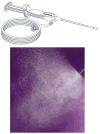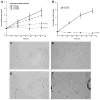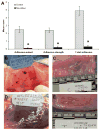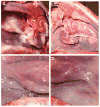A chitosan-based sinus sealant for reduction of adhesion formation in rabbit and sheep models
- PMID: 22492298
- PMCID: PMC3685821
- DOI: 10.1177/0194599812443647
A chitosan-based sinus sealant for reduction of adhesion formation in rabbit and sheep models
Abstract
Objective: Chronic sinusitis is the most prevalent chronic disease in the United States in adults aged 18 to 44 years, with approximately 250,000 operations performed annually. Although often successful, sinus surgery fails in greater than 15% of patients. Adhesion formation is a common complication and cause for subsequent revision surgery. Here, the authors evaluate a sprayable chitosan/starch-based sinus sealant and demonstrate its ability to reduce adhesion formation both in vitro and in 2 animal models.
Study design: Randomized, controlled, animal trials.
Setting: Academic medical center (fibroblast experiments) and animal laboratories (sheep and rabbit studies).
Subjects and methods: This sinus sealant was applied to human cultured fibroblasts obtained from surgically removed polyps to examine its ability to inhibit fibroblast migration and proliferation. The sinus sealant was applied to New Zealand White rabbits (n = 20) in an established cecal-sidewall abrasion model and to sheep (n = 10) in a sinus surgical adhesion model to examine its ability to reduce adhesion formation.
Results: This sinus sealant inhibited migration and proliferation of human cultured fibroblasts and reduced the total adhesion score from 4.9 to 0.3 for a total reduction of 94% (95th percentile confidence interval [CI], 78%, 100%; P < .001) in a well-established rabbit cecal-sidewall model commonly used for adhesion testing. Moreover, this sealant reduced adhesion formation from 80% to 10% for a total reduction of 70% (95th percentile CI, 57%, 93%; P = .003) in a sheep sinus adhesion surgical model.
Conclusion: This chitosan-based sealant demonstrates promise for reducing adhesion formation in sinus surgery.
Conflict of interest statement
Figures






Similar articles
-
Sprayable chitosan/starch-based sealant reduces adhesion formation in a sheep model for chronic sinusitis.Laryngoscope. 2013 Jan;123(1):42-7. doi: 10.1002/lary.23583. Epub 2012 Oct 15. Laryngoscope. 2013. PMID: 23070859 Clinical Trial.
-
Effects of a novel chitosan gel on mucosal wound healing following endoscopic sinus surgery in a sheep model of chronic rhinosinusitis.Laryngoscope. 2008 Jun;118(6):1088-94. doi: 10.1097/MLG.0b013e31816ba576. Laryngoscope. 2008. PMID: 18401274
-
Reduction in postoperative adhesion formation and re-formation after an abdominal operation with the use of N, O - carboxymethyl chitosan.Surgery. 2004 Mar;135(3):307-12. doi: 10.1016/j.surg.2003.07.005. Surgery. 2004. PMID: 14976481
-
The processing of chitosan and its derivatives and their application for postoperative anti-adhesion.Mini Rev Med Chem. 2015;15(4):330-7. doi: 10.2174/1389557515666150227110547. Mini Rev Med Chem. 2015. PMID: 25723456 Review.
-
Preclinical evaluation of Seprafilm bioresorbable membrane.Eur J Surg Suppl. 1997;(577):40-8. Eur J Surg Suppl. 1997. PMID: 9076451 Review.
Cited by
-
PVA-chitosan composite hydrogel versus alginate beads as a potential mesenchymal stem cell carrier for the treatment of focal cartilage defects.Knee Surg Sports Traumatol Arthrosc. 2015 May;23(5):1368-1377. doi: 10.1007/s00167-013-2723-5. Epub 2013 Oct 22. Knee Surg Sports Traumatol Arthrosc. 2015. PMID: 24146054
-
Antibodies directed against integration host factor mediate biofilm clearance from Nasopore.Laryngoscope. 2013 Nov;123(11):2626-32. doi: 10.1002/lary.24183. Epub 2013 May 13. Laryngoscope. 2013. PMID: 23670606 Free PMC article.
-
Safety and Efficacy of Topical Chitogel- Deferiprone-Gallium Protoporphyrin in Sheep Model.Front Microbiol. 2018 May 11;9:917. doi: 10.3389/fmicb.2018.00917. eCollection 2018. Front Microbiol. 2018. PMID: 29867828 Free PMC article.
References
-
- Benninger MS, Ferguson BJ, Hadley JA, et al. Adult chronic rhinosinusitis: definitions, diagnosis, epidemiology, and pathophysiology. Otolaryngol Head Neck Surg. 2003;129:S1–S32. - PubMed
-
- Pleis JR, Lucas JW, Ward BW. Summary health statistics for U.S. adults: National Health Interview Survey, 2008. Vital Health Stat. 2009;10(242):1–157. - PubMed
-
- Bhattacharyya N. Ambulatory sinus and nasal surgery in the United States: demographics and perioperative outcomes. Laryngoscope. 2010;120:635–638. - PubMed
-
- Bhattacharyya N, Orlandi RR, Grebner J, Martinson M. Cost burden of chronic rhinosinusitis: a claims-based study. Otolaryngol Head Neck Surg. 2011;144:440–445. - PubMed
-
- Senior BA, Kennedy DW, Tanabodee J, Kroger H, Hassab M, Lanza DC. Long-term results of functional endoscopic sinus surgery. Laryngoscope. 1998;108:151–157. - PubMed
Publication types
MeSH terms
Substances
Grants and funding
LinkOut - more resources
Full Text Sources
Medical

